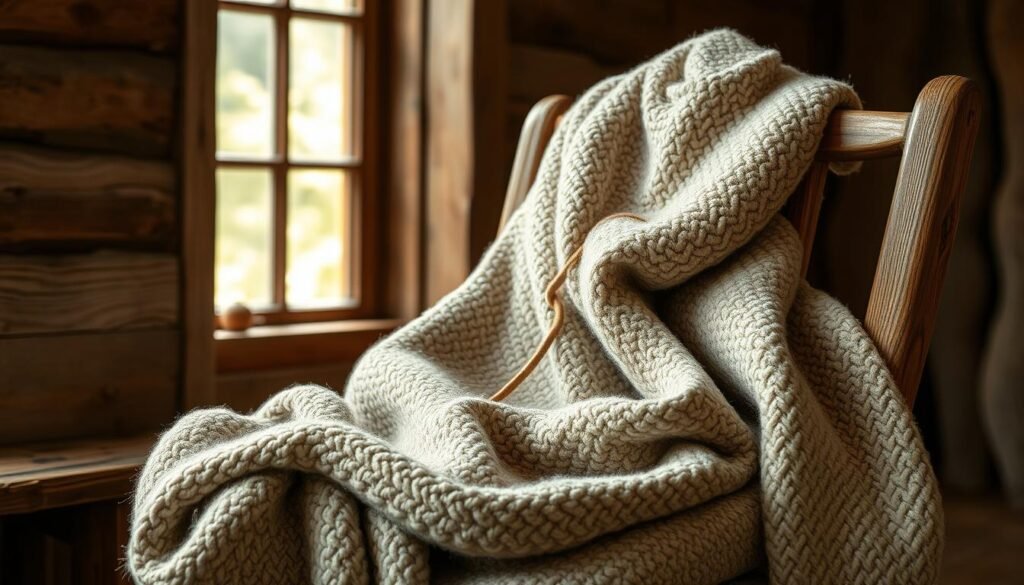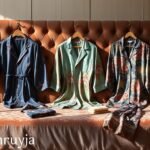“Fashion fades, only style remains the same,” said Coco Chanel. This wisdom lines up with the quest for the best hoodie material. Choosing fabrics for hoodies involves both fashion and function. It’s all about looking and feeling great in what you’re wearing.
Choosing the right fabric is crucial. For everyone, but especially for children with sensitive skin, cotton is the top pick for its comfort and breathability1. As the weather changes, so do our fabric choices. Fleece becomes a favorite in winter for its warmth2. Cotton-polyester blends are celebrated for their durability and comfort, lasting through many washes2.
Polyester is praised for being cost-effective and moisture-wicking. However, it’s not the best for breathability or long-term wear12. Spandex blends are gaining ground for active lifestyles. They offer stretch and comfort, moving with you2.
Key Takeaways
- Cotton fabric ensures safety and comfort for sensitive demographics1.
- High GSM fleece fabric is the go-to choice for cold weather hoodies2.
- The cotton-polyester blend strikes a balance between durability and coziness, suitable for regular wear2.
- Polyester’s resilience and quick-drying properties make it a contender for sporty apparel2.
- Wool and wool blends off warmth and durability but require thoughtful care for daily wear1.
- Spandex blends introduce essential flexibility without compromising the hoodie’s shape, ideal for active users2.
On the quest for the perfect hoodie, we explore a world of fabrics. Each material brings its own blend of style, comfort, and strength. Let’s take a closer look at what makes some hoodies stand out.
Understanding Hoodie Fabric Characteristics
Fabric choice is key for hoodie warmth, hoodie comfort, and performance. It’s crucial to know their qualities.
Warmth and Comfort: The Core Purpose of a Hoodie
The main goal of a hoodie is to keep you warm and cozy. Soft fabrics like fleece trap body heat well. This is especially so with thick fleece ranging from 350 to 400 GSM. They’re ideal for the cold, offering top warmth and insulation34.
Flexibility and Range of Motion for Active Use
For physical activities, fabric flexibility is crucial. French terry fabric is not only flexible but also breathable. It’s perfect for both workouts and daily wear. Stretchy materials, like cotton hosiery, can stretch up to 25%. Lightweight blends are also good for many activities5.
Durability: Investing in Long-Lasting Material
The material durability of a hoodie is important for its lifetime. Polyester is great for its durability and wrinkle resistance. It helps hoodies stay in great shape longer. A mix of 80/20 cotton-polyester adds durability while keeping the hoodie breathable for comfort3.
Aesthetic and Drapability: The Look and Fit
A stylish aesthetic hoodie must also have good fabric drapability. This affects its look and fit. The fabric choice greatly impacts how a hoodie looks. Fabrics like Sherpa and minky fleece look luxurious and feel rich. They help the hoodie drape softly, enhancing its look and comfort3.
Upgrade your closet with designs that mix style and personal touch at Tianruiyi. Here, quality craftsmanship shines in every item.
The Role of Cotton in Hoodie Fabrics
Cotton hoodies are popular for being soft and breathable. They are a must-have in closets all around the globe. Cotton is key in making sure these hoodies are cozy and useful in all kinds of weather and activities. Let’s see why cotton is the best for hoodies and what makes it so good.
Why Cotton is a Breathable Fabric
Cotton has a special structure that helps it soak up sweat and let it evaporate fast. This makes cotton hoodies keep you cool, even when it’s hot. The way cotton is woven lets air move freely, making it even more breathable6.
The Advantage of Cotton’s Moisture-Absorbing Qualities
Cotton can pull in moisture, which is why it’s often used for activewear. It can hold up to 27 times its weight in water. This draws sweat away from the body, helping to keep you dry and comfortable during exercise6.
The softness of cotton also means less skin irritation. This is great for wearing all day, whether you’re chilling or being active. Mixing cotton with other fibers, like spandex or polyester, adds both comfort and flexibility. This mix gives the perfect fit and movement without losing style or function78.
To sum up, choosing cotton for hoodies does more than provide comfort. It gives practical perks like managing moisture and being durable, all while ensuring breathability. These qualities make cotton fabric an outstanding choice for workout clothes and everyday outfits, perfectly blending coziness and style.
Distinguishing Between Different Types of Fleece Material
Fleece material stands out for its warmth and comfort, thanks to evolving fabric technologies. Exploring different types of fleece helps us see how they meet various needs with their special features.
Understanding the Insulating Properties of Fleece
Fleece is great for staying warm in cold weather. It comes in styles like polar fleece and sherpa fleece, which keep heat in well. Polar fleece is loved for outdoor clothing and blankets because it holds warmth superbly9. Sherpa fleece is super soft, mimicking real wool, and is excellent at keeping you cozy9.
The Diversity of Fleece: Weights and Breathability
The fleece’s weight affects its use. Microfleece is thin, perfect for exercising and wearing in layers because it breathes well and wicks away moisture9. Heavier fleece, though, is warmer but not as breathable10. This variety lets you pick the right fleece for your weather and activities.
When it comes to fleece and breathability, some wonder how it compares to fabrics like French terry. French terry is airy and wicks moisture away, but fleece offers unbeatable warmth in cold settings10. Choosing between them depends on how cold it is and what you’ll be doing.
In summary, fleece can be lightweight for active times or thick for cold days. Knowing about fleece’s insulating abilities, weight, and air flow helps you make the best pick. It ensures your fleece choice suits your environment and activities just right.
Choosing the Right Weight in Fabric for Climate Adaptability
When selecting hoodie material, the choice of fabric weight is crucial. It ensures the hoodie works well in various climates. The right fabric turns a hoodie into something you can wear all year. Otherwise, it might only be good for certain weather.
Hoodie fabrics come in many weights, each suited to different climates and levels of comfort. Fabrics like rayon and chambray are super light, under 4oz or 150 gsm. They’re great for hot weather because they let air flow through easily
| Fabric Type | Weight | Climate Suitability |
|---|---|---|
| Cotton | Light to Medium | Warm to hot |
| Fleece | Medium to Heavy | Cold |
| Wool Blend | Heavy | Very cold |
| Rayon | Very Light | Hot |
| Chambray | Light | Warm to Hot |
In warm weather, cotton and linen are tops for staying cool. They breathe well and soak up moisture, keeping you comfy even on hot days11. In cooler places, medium weight twill is great. It looks good and feels comfortable, making it a smart pick12.
When it gets colder, heavier fabrics like fleece or wool are key. They hold in warmth, perfect for winter. Heavy knits for sweaters also keep you warm and look good in the cold12.
For hoods that fit every climate, think about where and when you’ll wear them. This makes the hoodie more versatile and long-lasting. You’ll get more use across different seasons.
Picking the right fabric weight lets your hoodie fit into any season smoothly, offering style and comfort. Discover high-quality fabrics that up this flexibility and make smart choices for your needs.
Exploring French Terry for Year-Round Comfort
French terry hoodies stand out because of their comfort, strength, and flexibility for all seasons. This fabric has unique loops on one side and a smooth feel on the other, making it perfect for any time of the year. It keeps you warm without getting too hot, ideal for cold and warm weather alike. This feature has made it more popular, leading to a 6% growth in its global market every year13.
French terry is loved for its ability to wick away moisture. This keeps you dry and comfy, unlike fleece14. Around 70% of shoppers prefer clothes from cozy sweatshirt material that’s both airy and snug. Many say French terry is their favorite13.
French terry is also easy to care for. It doesn’t wrinkle much and can be cleaned in a gentle machine wash. This helps keep the fabric’s color and quality looking good over time14. Its ease of care and durability make it a top choice for casual and sporty clothing14.
| French Terry | Other Fabrics | |
|---|---|---|
| Moisture-wicking | High | Low-Medium |
| Maintenance | Easy | Varies |
| Year-Round Usage | Suitable | Limited |
| Consumer Preference | 70% High | Varies |
| Market Growth | 6% Annually | Stable/Declining |
Now, 30% of sportswear brands use French terry in their collections. When mixed with elastane, it becomes even more stretchy. This is perfect for cold places and active people1413. Its flexibility and practical benefits make French terry hoodies a top pick for those who want style and functionality13.
Discovering the Versatility of Polyester in Hoodies
Polyester hoodies are a key piece in casual wear. They offer affordability and versatility. This material’s popular use shows its balance between quality and cost.
Evaluating the Budget-friendliness of Polyester Hoodies
Polyester hoodies benefit from modern textile technology. They are known for their low cost, durability, and color retention. Mixing cotton and polyester improves fabric strength while keeping it comfortable. This mix shows a move towards practical and satisfying clothing15.
Polyester’s Maintenance: Caring for Your Hoodie
Caring for polyester hoodies is easy, making them a top choice for many. They resist wrinkles, keep their color, and don’t need special wash settings. This makes them durable and low maintenance. People love polyester for its ease of care, fitting the fast pace of modern life15.
Knowing about fabrics helps in choosing the right hoodie. Technical textiles make polyester better at insulation and breathability. This is key for activewear or jackets16. The trend is towards polyester and blends, for clothes that perform well for specific needs.

Below, a comparative analysis highlights polyester hoodies’ unique features compared to other materials:
| Material | Characteristic | Maintenance |
|---|---|---|
| Cotton | Soft, breathable | High |
| Polyester | Durable, wrinkle-resistant | Low |
| Wool | Warm, insulating | High |
| Nylon | Strong, abrasion-resistant | Low |
Polyester hoodies are not just cost-effective; they meet many needs. From easy care to lasting quality, they blend practicality with performance. This makes polyester key in the future of casual and active wear.
Selecting Stretchable Fabrics for Active Lifestyles
Choosing the right stretchable hoodie fabric is crucial for those with active lifestyles. Fabrics that mix practicality with comfort, like spandex, Lycra, and some polyester blends, are ideal. These materials are flexible and sturdy, perfect for intense activities. Their natural stretch means your clothes fit well and don’t limit movement, which is essential during workouts17.
Manufacturers understand the needs of active folks and have created flexible sweatshirt material to improve how it feels to wear. Properties like moisture-wicking and quick-drying are key. This is especially true for Polartec fleece, which comes in different weights for various climates and activities18.
For those who care about the environment and performance, bamboo or TENCEL™ Lyocell fabrics are great. These materials are sustainable and comfy, fitting perfectly into an active lifestyle. They also help reduce environmental impact1719. Specifically, bamboo fabric is excellent at managing moisture and resisting odors. It’s perfect for outdoor sports or workouts that require staying fresh and comfortable17.
- Moisture management in fabrics is crucial for staying dry and comfortable during intense workouts.
- Stretchy materials like spandex are best for exercises that need a lot of movement17.
- Eco-friendly and high-performing options like TENCEL™ Lyocell not only control bacteria well but also are gentle on skin, improving physical activity.
The perfect active lifestyle apparel combines functionality, comfort, and eco-friendliness. Whether doing yoga or hiking, the right stretchable fabric can boost your performance and enjoyment. As people want better workout clothes, the adaptability and quality of materials like spandex, bamboo, and advanced polyesters stand out in sportswear.
Benefits of Integrating Wool into Hoodie Fabric
Wool hoodies are leading the eco-friendly clothing market with their comfort and sustainability. These hoodies come from sheep’s natural fibers. They bring many advantages that you can’t ignore.
Wool is great because it helps control your temperature. It reacts to your body’s temperature changes. It keeps you warm in cold weather and cool in hot weather20. Wool hoodies work well in all kinds of weather. They can absorb moisture from your body and release it. This helps you stay comfortable, even if you’re sweating20.
Wool hoodies are also good for the planet. They are sustainable, biodegradable, and have low energy needs and greenhouse gas emissions21. As people want more eco-friendly clothes, wool hoodies are becoming a popular choice.
| Eco-Friendly Feature | Benefit |
|---|---|
| Biodegradable | Breaks down naturally, reducing waste |
| Renewable | Continuously available resource without depleting nature |
| Low greenhouse gas emissions | Contributes less to global warming |
Wool doesn’t just help the environment or manage temperature. It’s also long-lasting. A wool fiber can bend 20,000 times without breaking20. This means wool hoodies don’t wear out quickly. They’re a good investment because they last a long time.
Wool also keeps you safe in other ways. It’s hard to catch on fire because it’s flame-resistant21. It also protects you from the sun’s harmful rays20.

Choosing wool for hoodie fabric means you’re picking a material that’s comfortable, safe, and good for our earth. It shows a commitment to quality and caring for our planet. This makes it an excellent decision for both makers and wearers of clothes.
Finding the Balance with Blend Fabrics
Blended fabrics are leading the way for balanced hoodie materials. They cleverly mix natural and synthetic fibers to make high-quality textiles. These blends combine the softness and comfort of cotton with the durability of synthetic fibers like polyester. This mix makes the fabric resilient, less likely to shrink, and easy to care for22.
But there’s more innovation to come. Adding stretchy spandex to rayon makes fabrics that are comfortable yet allow for movement. For those who love the outdoors, cotton-nylon blends offer resistance to moisture and are sturdy. In cold weather, blending cotton with wool provides warmth without sacrificing durability. This makes it a good choice for winter clothes22.
Blended fabrics bring many benefits like more stretch from spandex23 and quicker drying from mixing cotton with synthetic fibers23. They also offer better breathability with merino wool blends23. However, it’s important to think about the environment. Washing synthetic blends releases microplastics, harming our ecosystems23. So, eco-friendly shoppers might look into blends with recycled fibers like rPET23. To learn more about choosing materials wisely, visit this fabric knowledge-sharing website. It’s a place to talk about blended fabrics’ effects on comfort and the environment23.
FAQ
How do I choose the right fabric for a durable and lightweight hoodie?
Look for materials like cotton, French terry, or lightweight fleece. These balance weight and durability. Check for breathability, how well it wicks away moisture, and its weight to make sure it’s comfortable yet tough.
What makes a hoodie fabric provide warmth and comfort?
For warmth, choose fleece or wool for their insulating capabilities. You’ll stay warm. Comfort comes from softness, how well the fabric breathes, and its ability to wick moisture, like with cotton or some fleeces.
What kind of hoodie fabric should I look for if I’m active and need flexibility?
Select stretchy fabrics such as French terry, jersey knit, or blends with spandex. They stretch well for physical activities and offer comfort.
How does the durability of a hoodie fabric affect its longevity?
Materials like thick fleece, cotton, and blends withstand wear and tear well. This keeps your hoodie looking good over time. Picking a durable fabric means it’ll hold up with frequent washes and everyday wear.
Why is fabric drapability important for a hoodie’s aesthetic?
Drapability is how fabric hangs on the body. A good drapability, like with French terry, means the hoodie will look flattering and stylish.
How does cotton contribute to hoodie comfort?
Cotton is great for staying cool and dry since it breathes and absorbs moisture. Its softness and being hypoallergenic add to a hoodie’s comfort.
What are the benefits of fleece in hoodie materials?
Fleece keeps you warm without being bulky. It’s available in different weights, so you can choose how warm and breathable your hoodie is, perfect for all climates.
Why should I consider the weight of fabric for a climate-adaptable hoodie?
Light fabrics like jersey are good for warm weather. Heavier materials, like wool blends, keep you warm in the cold. The right weight makes your hoodie versatile.
What makes French terry a good choice for hoodies throughout the year?
French terry gives you mid-level warmth, making it right for many temperatures. Its stretch and shape maintenance means it’s comfortable all year.
How budget-friendly are polyester hoodies, and are they easy to maintain?
Polyester hoodies can save you money and are simple to care for. They resist shrinking and stains but remember, they might not breathe as well as natural fabrics.
Why would someone choose a stretchable fabric for a hoodie in an active lifestyle?
When you’re active, you need clothes that move with you. Fabrics that stretch, like jersey or blends with spandex, offer flexibility and comfort during exercise or any active pursuit.
What are the eco-friendly advantages of choosing wool for hoodie fabrics?
Wool is eco-friendly because it’s natural and sustainable. It regulates temperature well, is breathable, keeps you warm, and is renewable. A great choice for eco-conscious hoodie shoppers.
How do blended fabrics offer a balanced option for hoodies?
Blends like cotton-polyester or rayon-spandex mix different fibers’ strengths. They offer breathability, durability, and stretch, custom-fitting your hoodie for comfort, function, and style.
Source Links
- How To Choose The Best Fabric For Hoodies
- No title found
- Best Hoodie Material: The Ultimate Guide For Perfect Fit
- Best Types Of Material For A Hoodie To Choose In 2024
- Which Fabric Should I Choose for Hoodies & Sweatshirts Collection? [Ultimate Guide 2024]
- Best Hoodie Materials 101: Which Fabrics Should You Choose?
- 10 Types of Hoodie Materials | Pros & Cons
- Choosing the Best Fabric for Hoodies
- From Sherpa To Slub: The Types Of Fleece To Know
- French Terry vs Fleece: What’s the Difference?
- The Best Fabrics For Hot Weather: Breathable Fabric For Summer – Fabricare Center
- No title found
- What is French Terry? A Comprehensive Guide by TAF
- French Terry Fabric: Everything You Need to Know
- Exploring Different Kinds of Compositions and Different Fabric Types – Lezhou Garment
- No title found
- All About Activewear Materials: The right fabric for your workout
- The ultimate guide to activewear fabrics – The Last Stitch
- Choosing the Best Workout Fabric: Expert Tips
- Benefits and features of merino wool
- Choosing the Right Base Layer Fabric: Wool vs. Polyester
- The Ultimate Guide to Cotton Blend Fabrics: Comfort Meets Fashion
- 7 things you need to know about blended fabrics




